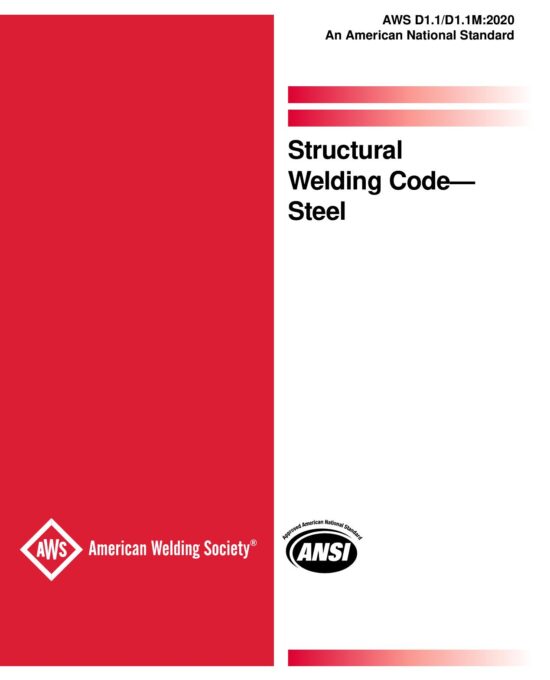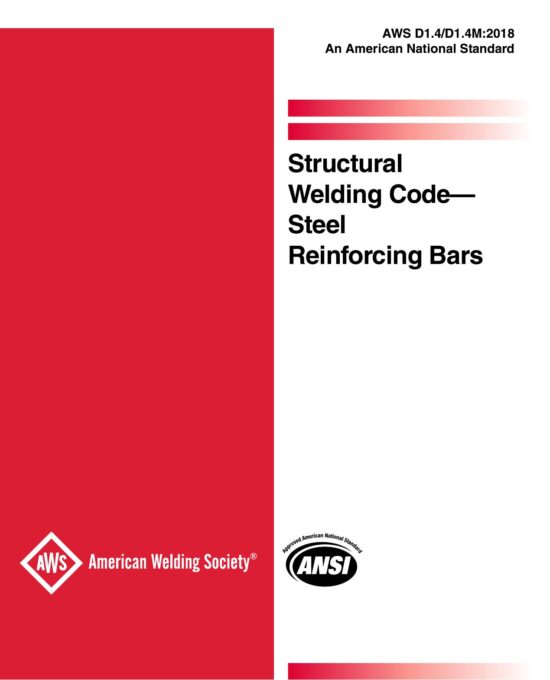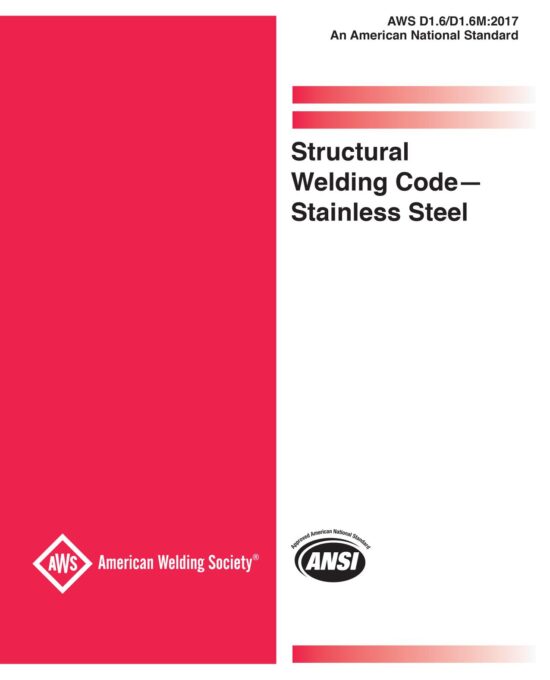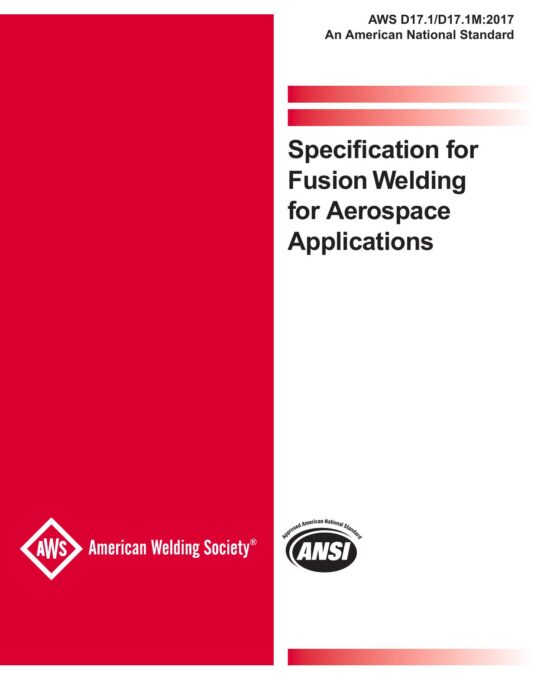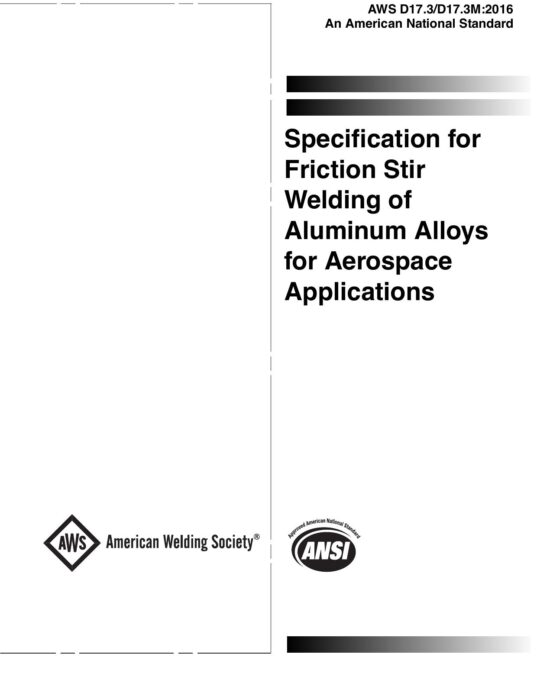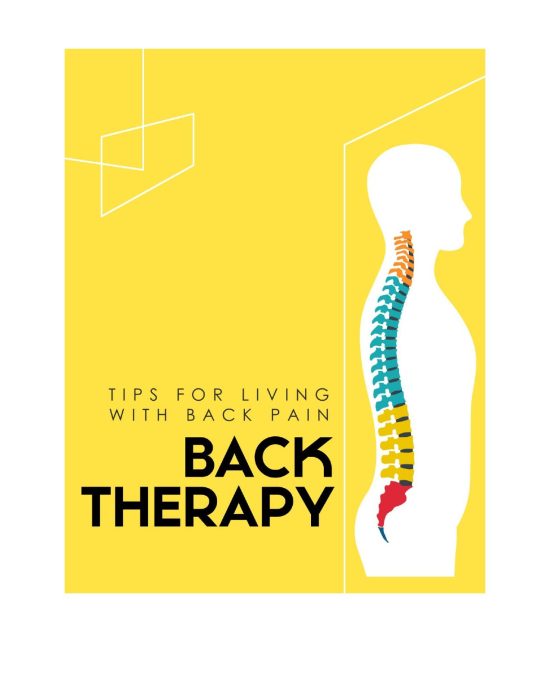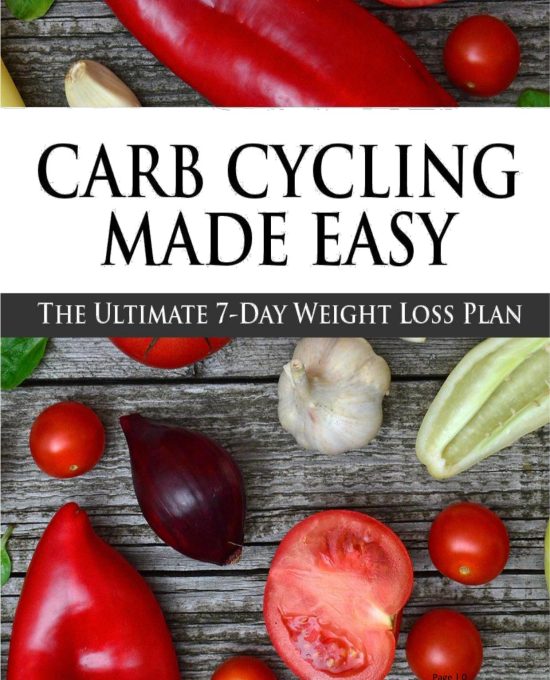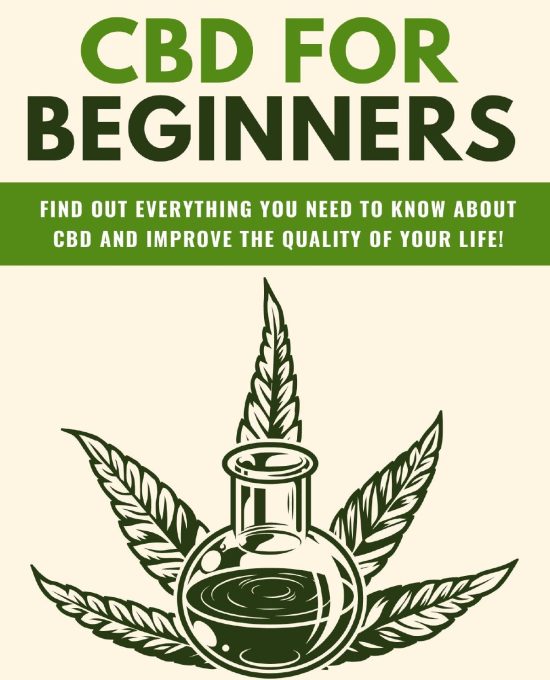AWS D1.1/D1.1M:2020 – Structural Welding Code – Steel
AWS D1.1/D1.1M:2020 – Structural Welding Code – Steel is the 24th edition of the code and serves as the definitive standard for welding carbon and low-alloy steel structures. Approved by ANSI and published by the American Welding Society, it reflects the latest best practices in structural welding design, fabrication, and inspection.
Highlights:
- Welding requirements for carbon and low-alloy steels
- Design criteria for welded joints in tubular and nontubular members
- Prequalification standards for Welding Procedure Specifications (WPS)
- Qualification tests for welding procedures and personnel
- Rules for fabrication, inspection, repair, and stud welding
- Guidance for strengthening and retrofitting existing structures
- Covers steel 1/8 in [3 mm] or thicker, up to 100 ksi [690 MPa] yield strength
- Includes mandatory clauses, normative and informative annexes, and detailed commentary
Who It’s For:
Structural engineers, welders, inspectors, and contractors engaged in the design, construction, and quality control of welded steel structures in buildings, bridges, towers, and industrial facilities.
AWS D1.1/D1.1M:2020
AWS D1.1/D1.1M:2020 – Structural Welding Code – Steel
AWS D1.1/D1.1M:2020 – Structural Welding Code – Steel is the 24th edition of the code and serves as the definitive standard for welding carbon and low-alloy steel structures. Approved by ANSI and published by the American Welding Society, it reflects the latest best practices in structural welding design, fabrication, and inspection.
Highlights:
- Welding requirements for carbon and low-alloy steels
- Design criteria for welded joints in tubular and nontubular members
- Prequalification standards for Welding Procedure Specifications (WPS)
- Qualification tests for welding procedures and personnel
- Rules for fabrication, inspection, repair, and stud welding
- Guidance for strengthening and retrofitting existing structures
- Covers steel 1/8 in [3 mm] or thicker, up to 100 ksi [690 MPa] yield strength
- Includes mandatory clauses, normative and informative annexes, and detailed commentary
Who It’s For:
Structural engineers, welders, inspectors, and contractors engaged in the design, construction, and quality control of welded steel structures in buildings, bridges, towers, and industrial facilities.
AWS D1.1/D1.1M:2020
AWS D1.4/D1.4M:2018 – Structural Welding Code – Steel Reinforcing Bars
AWS D1.4/D1.4M:2018 – Structural Welding Code – Steel Reinforcing Bars provides welding requirements for deformed and plain reinforcing bars used in reinforced concrete construction. Applicable to structural projects such as buildings, bridges, and infrastructure systems, this code ensures weld quality, safety, and compliance in both field and shop conditions.
Highlights:
- Covers Shielded Metal Arc Welding (SMAW) and Gas Tungsten Arc Welding (GTAW) as prequalified processes
- Design rules for welded joints, lap splices, and bar anchorage
- Base metal, filler metal, and electrode specifications
- Preheat/interpass temperature guidance based on carbon equivalent
- Weld profile and workmanship requirements
- Qualification criteria for welders, welding procedures, and inspectors
- Visual and radiographic inspection procedures
- Surface preparation and protection requirements for field/shop welding
- Includes normative and informative annexes for expanded guidance
- Commentary section explains code intent and technical decisions
Who It’s For:
Structural engineers, contractors, inspectors, and welders engaged in the welding of reinforcing steel in seismic, heavy civil, and structural applications.
AWS D1.4/D1.4M:2018
AWS D1.4/D1.4M:2018 – Structural Welding Code – Steel Reinforcing Bars
AWS D1.4/D1.4M:2018 – Structural Welding Code – Steel Reinforcing Bars provides welding requirements for deformed and plain reinforcing bars used in reinforced concrete construction. Applicable to structural projects such as buildings, bridges, and infrastructure systems, this code ensures weld quality, safety, and compliance in both field and shop conditions.
Highlights:
- Covers Shielded Metal Arc Welding (SMAW) and Gas Tungsten Arc Welding (GTAW) as prequalified processes
- Design rules for welded joints, lap splices, and bar anchorage
- Base metal, filler metal, and electrode specifications
- Preheat/interpass temperature guidance based on carbon equivalent
- Weld profile and workmanship requirements
- Qualification criteria for welders, welding procedures, and inspectors
- Visual and radiographic inspection procedures
- Surface preparation and protection requirements for field/shop welding
- Includes normative and informative annexes for expanded guidance
- Commentary section explains code intent and technical decisions
Who It’s For:
Structural engineers, contractors, inspectors, and welders engaged in the welding of reinforcing steel in seismic, heavy civil, and structural applications.
AWS D1.4/D1.4M:2018
AWS D1.6/D1.6M:2017 – Structural Welding Code – Stainless Steel
AWS D1.6/D1.6M:2017 – Structural Welding Code – Stainless Steel defines the welding requirements for austenitic and ferritic stainless steel structural components. Applicable to both shop and field fabrication, it governs the construction of non-pressure stainless steel structures and aligns closely with AWS D1.1 formatting for consistency.
Highlights:
- Design provisions for welded joints and structural connection details
- Specifications for base metals, filler materials, and qualified welding processes
- Prequalification criteria for procedures and joint configurations
- Qualification standards for welding procedures, welders, and operators
- Visual and nondestructive inspection methods
- Stud welding practices and performance qualification requirements
- Fabrication standards for cleaning, joint prep, and weld profile control
- Weld acceptance criteria and repair guidelines
- Normative and informative annexes on weld sizing, filler metal selection, sample forms, and macroetchants
- Commentary section offering interpretation and application guidance
Who It’s For:
Essential for fabricators, engineers, inspectors, and contractors involved in stainless steel construction for structural applications such as architectural systems, industrial frameworks, and corrosion-resistant environments.
AWS D1.6/D1.6M:2017
AWS D1.6/D1.6M:2017 – Structural Welding Code – Stainless Steel
AWS D1.6/D1.6M:2017 – Structural Welding Code – Stainless Steel defines the welding requirements for austenitic and ferritic stainless steel structural components. Applicable to both shop and field fabrication, it governs the construction of non-pressure stainless steel structures and aligns closely with AWS D1.1 formatting for consistency.
Highlights:
- Design provisions for welded joints and structural connection details
- Specifications for base metals, filler materials, and qualified welding processes
- Prequalification criteria for procedures and joint configurations
- Qualification standards for welding procedures, welders, and operators
- Visual and nondestructive inspection methods
- Stud welding practices and performance qualification requirements
- Fabrication standards for cleaning, joint prep, and weld profile control
- Weld acceptance criteria and repair guidelines
- Normative and informative annexes on weld sizing, filler metal selection, sample forms, and macroetchants
- Commentary section offering interpretation and application guidance
Who It’s For:
Essential for fabricators, engineers, inspectors, and contractors involved in stainless steel construction for structural applications such as architectural systems, industrial frameworks, and corrosion-resistant environments.
AWS D1.6/D1.6M:2017
AWS D17.1/D17.1M:2017 – Specification for Fusion Welding for Aerospace Applications
AWS D17.1/D17.1M:2017 establishes the welding requirements for aircraft, aerospace, and space hardware using electric arc and high-energy beam fusion welding processes. It covers aluminum, nickel, iron, cobalt, titanium, and magnesium alloys and supports both flight-critical and support structure applications.
Highlights:
- Design criteria for aerospace weld joints
- Qualification requirements for procedures and personnel
- Fabrication, inspection, and acceptance standards
- Repair guidance for aerospace components
- Preweld/postweld processes including traceability and cleaning
- Visual and nondestructive exam methods with acceptance criteria
- Normative/informative annexes on bend tests, positions, acronyms, and forms
- Commentary with technical interpretation and best practices
New in the 2017 Edition:
- Annexes for UNS material designations
- Expanded welding position coverage and standardized forms
- Editorial updates for clarity and usability
Who’s It For:
Aerospace engineers, welding supervisors, inspectors, and quality professionals involved in the fabrication or evaluation of welded aerospace structures.
AWS D17.1/D17.1M-2017
AWS D17.1/D17.1M:2017 – Specification for Fusion Welding for Aerospace Applications
AWS D17.1/D17.1M:2017 establishes the welding requirements for aircraft, aerospace, and space hardware using electric arc and high-energy beam fusion welding processes. It covers aluminum, nickel, iron, cobalt, titanium, and magnesium alloys and supports both flight-critical and support structure applications.
Highlights:
- Design criteria for aerospace weld joints
- Qualification requirements for procedures and personnel
- Fabrication, inspection, and acceptance standards
- Repair guidance for aerospace components
- Preweld/postweld processes including traceability and cleaning
- Visual and nondestructive exam methods with acceptance criteria
- Normative/informative annexes on bend tests, positions, acronyms, and forms
- Commentary with technical interpretation and best practices
New in the 2017 Edition:
- Annexes for UNS material designations
- Expanded welding position coverage and standardized forms
- Editorial updates for clarity and usability
Who’s It For:
Aerospace engineers, welding supervisors, inspectors, and quality professionals involved in the fabrication or evaluation of welded aerospace structures.
AWS D17.1/D17.1M-2017
AWS D17.3/D17.3M:2016 – Specification for Friction Stir Welding of Aluminum Alloys for Aerospace Applications
AWS D17.3/D17.3M:2016 establishes general requirements for the friction stir welding (FSW) of aluminum alloys in aerospace applications. It provides standardized procedures for the design, fabrication, qualification, and inspection of aerospace components joined using the FSW process.
Highlights:
- Design requirements for FSW joints in aerospace structures
- Qualification procedures for welders, operators, and welding procedures
- Approved base metal specifications and usage limitations
- Tooling, fixture, and FSW equipment setup requirements
- Fabrication guidelines for welding parameters and process control
- Visual and mechanical inspection methods for weld quality verification
- Acceptance criteria for discontinuities, mechanical properties, and visual appearance
- Quality assurance provisions, documentation, and recordkeeping standards
New in the 2016 Edition:
- Updates to reflect advancements in friction stir welding techniques and aerospace material performance
- Enhanced inspection and qualification procedures for improved compliance and reliability
- Supersedes AWS D17.3/D17.3M:2010
Who’s It For:
Aerospace engineers, quality professionals, and fabricators involved in the production or qualification of aluminum structures using friction stir welding.
AWS D17.3/D17.3M-2016
AWS D17.3/D17.3M:2016 – Specification for Friction Stir Welding of Aluminum Alloys for Aerospace Applications
AWS D17.3/D17.3M:2016 establishes general requirements for the friction stir welding (FSW) of aluminum alloys in aerospace applications. It provides standardized procedures for the design, fabrication, qualification, and inspection of aerospace components joined using the FSW process.
Highlights:
- Design requirements for FSW joints in aerospace structures
- Qualification procedures for welders, operators, and welding procedures
- Approved base metal specifications and usage limitations
- Tooling, fixture, and FSW equipment setup requirements
- Fabrication guidelines for welding parameters and process control
- Visual and mechanical inspection methods for weld quality verification
- Acceptance criteria for discontinuities, mechanical properties, and visual appearance
- Quality assurance provisions, documentation, and recordkeeping standards
New in the 2016 Edition:
- Updates to reflect advancements in friction stir welding techniques and aerospace material performance
- Enhanced inspection and qualification procedures for improved compliance and reliability
- Supersedes AWS D17.3/D17.3M:2010
Who’s It For:
Aerospace engineers, quality professionals, and fabricators involved in the production or qualification of aluminum structures using friction stir welding.
AWS D17.3/D17.3M-2016
Back Therapy – Tips for Living with Back Pain
- Identify everyday habits that contribute to back pain—and how to fix them.
- Improve posture, movement, and lifting techniques to reduce strain.
- Choose exercises that strengthen without causing harm.
- Explore treatment options like physical therapy, chiropractic care, or medical consultation.
- Adopt a mindset of acceptance while still pursuing relief and better living.
Back Therapy – Tips for Living with Back Pain
- Identify everyday habits that contribute to back pain—and how to fix them.
- Improve posture, movement, and lifting techniques to reduce strain.
- Choose exercises that strengthen without causing harm.
- Explore treatment options like physical therapy, chiropractic care, or medical consultation.
- Adopt a mindset of acceptance while still pursuing relief and better living.
Become the Best Version of Yourself – How to Transform Your Life and Claim Your Personal Power
- Identify the masks you wear and why you adopted them.
- Heal core emotional wounds like abandonment, rejection, or betrayal.
- Set boundaries without guilt and stop people-pleasing behaviors.
- Boost self-confidence and self-esteem through mindful practices.
- Align your daily life with your true values, strengths, and desires.
Become the Best Version of Yourself – How to Transform Your Life and Claim Your Personal Power
- Identify the masks you wear and why you adopted them.
- Heal core emotional wounds like abandonment, rejection, or betrayal.
- Set boundaries without guilt and stop people-pleasing behaviors.
- Boost self-confidence and self-esteem through mindful practices.
- Align your daily life with your true values, strengths, and desires.
Breathe – How to Stay Calm, Confident and Collected in Even the Most Stressful Situations
- Shift from anxiety to "flow" and peak focus with breathing and posture.
- Use CBT techniques to challenge panic, phobias, and anxious thoughts.
- Apply meditation, grounding, and visualizations to regulate emotions.
- Understand neurotransmitters and natural methods to balance them.
- Avoid common cognitive traps and make better decisions under stress.
Breathe – How to Stay Calm, Confident and Collected in Even the Most Stressful Situations
- Shift from anxiety to "flow" and peak focus with breathing and posture.
- Use CBT techniques to challenge panic, phobias, and anxious thoughts.
- Apply meditation, grounding, and visualizations to regulate emotions.
- Understand neurotransmitters and natural methods to balance them.
- Avoid common cognitive traps and make better decisions under stress.
Carb Cycling Made Easy – The Ultimate 7-Day Weight Loss Plan
- Follow a 7-day plan that boosts metabolism while burning fat.
- Calculate your ideal intake of carbs, proteins, and fats for high and low carb days.
- Choose healthy carbs and avoid common mistakes that sabotage progress.
- Create satisfying, flexible meals with easy-to-follow plans and real food.
- Stay motivated with cheat days, realistic expectations, and sustainable habits.
Carb Cycling Made Easy – The Ultimate 7-Day Weight Loss Plan
- Follow a 7-day plan that boosts metabolism while burning fat.
- Calculate your ideal intake of carbs, proteins, and fats for high and low carb days.
- Choose healthy carbs and avoid common mistakes that sabotage progress.
- Create satisfying, flexible meals with easy-to-follow plans and real food.
- Stay motivated with cheat days, realistic expectations, and sustainable habits.
CBD for Beginners – Find Out Everything You Need to Know About CBD and Improve the Quality of Your Life
- Understand what CBD is, how it’s extracted, and how it differs from THC.
- Choose the right form and dosage for conditions like anxiety, arthritis, or insomnia.
- Identify high-quality, full-spectrum products versus misleading or low-grade options.
- Avoid common buying pitfalls and ensure product safety.
- Separate fact from fiction in the most common CBD myths.
CBD for Beginners – Find Out Everything You Need to Know About CBD and Improve the Quality of Your Life
- Understand what CBD is, how it’s extracted, and how it differs from THC.
- Choose the right form and dosage for conditions like anxiety, arthritis, or insomnia.
- Identify high-quality, full-spectrum products versus misleading or low-grade options.
- Avoid common buying pitfalls and ensure product safety.
- Separate fact from fiction in the most common CBD myths.
Clothing 101 – A Comprehensive Guide All About Clothing
- Choose clothing that suits your body type, complexion, and personal style.
- Dress for confidence, not just trends—at work, at home, or on a night out.
- Shop smarter with practical wardrobe-building tips for every budget.
- Avoid common fashion mistakes and find the right fit for any occasion.
- Help kids and teens dress comfortably, stylishly, and age-appropriately.
Clothing 101 – A Comprehensive Guide All About Clothing
- Choose clothing that suits your body type, complexion, and personal style.
- Dress for confidence, not just trends—at work, at home, or on a night out.
- Shop smarter with practical wardrobe-building tips for every budget.
- Avoid common fashion mistakes and find the right fit for any occasion.
- Help kids and teens dress comfortably, stylishly, and age-appropriately.
Communication Made Simple
- Identify and clarify the core message you want to share.
- Use words and phrases that spark interest and emotional engagement.
- Read and project confident body language that reinforces your message.
- Speak clearly and concisely—even under pressure.
- Deliver a compelling message in under one minute.
Communication Made Simple
- Identify and clarify the core message you want to share.
- Use words and phrases that spark interest and emotional engagement.
- Read and project confident body language that reinforces your message.
- Speak clearly and concisely—even under pressure.
- Deliver a compelling message in under one minute.
